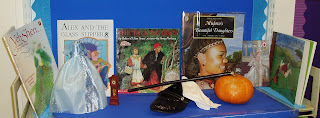On Thursday night, I used
this site to contact a few tourist information boards, saying in the comments section that I was a teacher working on a geography project with my class. This morning (only two days later!) I received information from
Sri Lanka and Korea. They've sent me loads of useful stuff, including maps and cultural information booklets. There's also a directory of tourist boards
here, which sometimes has links to order brochures.
I've also spent this morning going round travel agents to collect brochures. I'm trying to find space in my classroom to set up a travel agent role play area, inspired by ideas from
Trinity Educational (including a free download of ideas, photos and a booking form template for children to use) and
Role Play Online.
I'm going to try to use this in maths, for example:
- data handling - weather graphs and statistics
- time - timetables, flight departure times, itineraries
- calculations - travel, hotel and attraction prices
- measures - weight and size allowances for luggage
I'll also use it in literacy, for example designing adverts, brochures and tourist information. And obviously it will link in with geography!
 Coloured presents sparkle dreamily,
Coloured presents sparkle dreamily,

